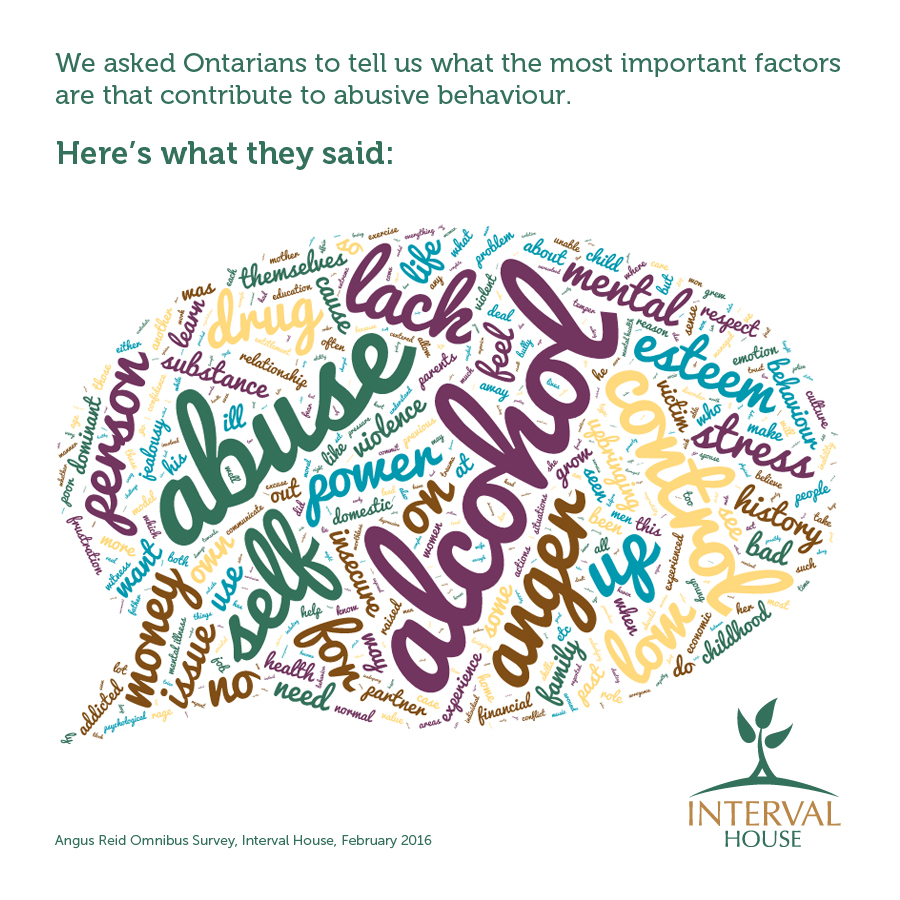
In February of this year, Interval House posed this question to Ontarians through an Angus Reid Omnibus Survey: “What are the most important factors that contribute to abusive behaviour?” We let them answer in their own words and used the most common responses to make a word cloud. Each week for the next month, we’re addressing a common attitude about the causes of domestic violence to investigate: is it true? Or is it a myth? In this post, we answer: does a desire for power and control cause domestic violence?
For the past month, we’ve covered many of the popular beliefs about what causes domestic violence. In this final post, we’re going to cover the last theme that emerged when we talked to Ontarians: power and control.

If you take a look at the word cloud, “control” was one of the most popular responses; “power” was also a common response. Is domestic violence caused by a desire for power and control?
TRUE: As you may have guessed if you read the other posts in our series, domestic violence is usually caused by the abuser feeling entitled to hold a position of power over their partner.
For example, in last week’s post, we talked about how wanting to be powerful and controlling can be a learned behaviour for abusers who experienced or witnessed abuse as children. And in other weeks, we talked about how power and control are the real motivations, even in cases involving an abuser’s substance abuse, mental illness, or anger management problems.
The underlying cause is the desire for power and control – it’s the common denominator in every abusive intimate partner relationship.
Anti-violence advocates and women’s organizations often use the “Power and Control Wheel” 1 to show the common behaviours that abusers use to establish and maintain control over their partner. This model explains domestic violence as involving a continuum of behaviours that overlap:
- Coercion & threats
- Emotional abuse
- Minimizing, denying, blaming
- Using children
- Economic abuse
- Male privilege
All of these behaviours are about one partner controlling the other. Physical violence in an abusive relationship is often accompanied by “domestic terrorism”: emotional, psychological, and financial abuse that further erodes their partner’s independence, self-esteem, and access to the outside world.
And this power and control is usually gendered. The reason that people who identify as women represent the vast majority of abuse survivors is because of the belief that men have a right to control women. This goes beyond an individual partner’s alcoholism or anger management issues: it’s a systemic issue that stems from widespread beliefs about women being “less than” men.
Of course, we see this gendered power imbalance at play outside of abusive relationships:
- When women face sexual harassment and assault walking down the street, in their schools, workplaces, and homes
- When women earn less than men and are less represented in positions of power in business and government
- When women are blamed by their families, friends, or others when they talk about violence they experienced
- And in a whole host of other situations that people who identify as women confront every day
But, if domestic violence is about a bigger system that sets up men to have power and control over women, then… how do we even begin to end domestic violence?
Well, there’s obviously not an easy answer. But if domestic violence is about attitudes towards women, we can challenge those attitudes. To work to end the root causes of domestic violence we can:
- Speak out about the issue of violence against women
- Hold perpetrators of violence accountable, and not excuse their violence
- Believe survivors of violence who share their stories and tell them it’s not their fault
- Support opportunities for women to become independent and economically self-sufficient, like Interval House’s BESS program
The causes of abusive behaviour may not be straightforward, but we can still work to end domestic violence. Learn how else you can take action.
This is the last post in our myth-busting series. Check out our earlier posts:
- Part 1: What are the causes of domestic violence?
- Part 2: Does substance abuse cause domestic violence?
- Part 3: Does mental illness or anger cause domestic violence?
- Part 4: Does a history of childhood abuse cause abusive behaviour?
- Part 5: Is domestic violence about power and control?
Sources:
- © 2011 Duluth Model Power and Control Wheels from Domestic Abuse Intervention Programs www.ncdsv.org/images/powercontrolwheelnoshading.pdf

